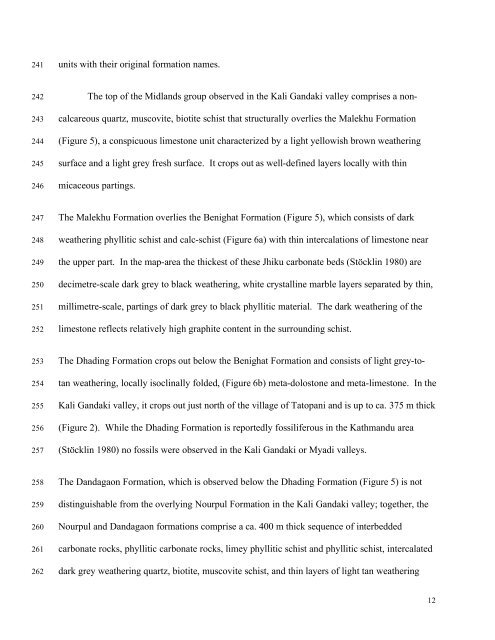Kinematics of the Greater Himalayan sequence, Dhaulagiri Himal ...
Kinematics of the Greater Himalayan sequence, Dhaulagiri Himal ...
Kinematics of the Greater Himalayan sequence, Dhaulagiri Himal ...
Create successful ePaper yourself
Turn your PDF publications into a flip-book with our unique Google optimized e-Paper software.
241<br />
units with <strong>the</strong>ir original formation names.<br />
242<br />
243<br />
244<br />
245<br />
246<br />
The top <strong>of</strong> <strong>the</strong> Midlands group observed in <strong>the</strong> Kali Gandaki valley comprises a noncalcareous<br />
quartz, muscovite, biotite schist that structurally overlies <strong>the</strong> Malekhu Formation<br />
(Figure 5), a conspicuous limestone unit characterized by a light yellowish brown wea<strong>the</strong>ring<br />
surface and a light grey fresh surface. It crops out as well-defined layers locally with thin<br />
micaceous partings.<br />
247<br />
248<br />
249<br />
250<br />
251<br />
252<br />
The Malekhu Formation overlies <strong>the</strong> Benighat Formation (Figure 5), which consists <strong>of</strong> dark<br />
wea<strong>the</strong>ring phyllitic schist and calc-schist (Figure 6a) with thin intercalations <strong>of</strong> limestone near<br />
<strong>the</strong> upper part. In <strong>the</strong> map-area <strong>the</strong> thickest <strong>of</strong> <strong>the</strong>se Jhiku carbonate beds (Stöcklin 1980) are<br />
decimetre-scale dark grey to black wea<strong>the</strong>ring, white crystalline marble layers separated by thin,<br />
millimetre-scale, partings <strong>of</strong> dark grey to black phyllitic material. The dark wea<strong>the</strong>ring <strong>of</strong> <strong>the</strong><br />
limestone reflects relatively high graphite content in <strong>the</strong> surrounding schist.<br />
253<br />
254<br />
255<br />
256<br />
257<br />
The Dhading Formation crops out below <strong>the</strong> Benighat Formation and consists <strong>of</strong> light grey-totan<br />
wea<strong>the</strong>ring, locally isoclinally folded, (Figure 6b) meta-dolostone and meta-limestone. In <strong>the</strong><br />
Kali Gandaki valley, it crops out just north <strong>of</strong> <strong>the</strong> village <strong>of</strong> Tatopani and is up to ca. 375 m thick<br />
(Figure 2). While <strong>the</strong> Dhading Formation is reportedly fossiliferous in <strong>the</strong> Kathmandu area<br />
(Stöcklin 1980) no fossils were observed in <strong>the</strong> Kali Gandaki or Myadi valleys.<br />
258<br />
259<br />
260<br />
261<br />
262<br />
The Dandagaon Formation, which is observed below <strong>the</strong> Dhading Formation (Figure 5) is not<br />
distinguishable from <strong>the</strong> overlying Nourpul Formation in <strong>the</strong> Kali Gandaki valley; toge<strong>the</strong>r, <strong>the</strong><br />
Nourpul and Dandagaon formations comprise a ca. 400 m thick <strong>sequence</strong> <strong>of</strong> interbedded<br />
carbonate rocks, phyllitic carbonate rocks, limey phyllitic schist and phyllitic schist, intercalated<br />
dark grey wea<strong>the</strong>ring quartz, biotite, muscovite schist, and thin layers <strong>of</strong> light tan wea<strong>the</strong>ring<br />
12

















